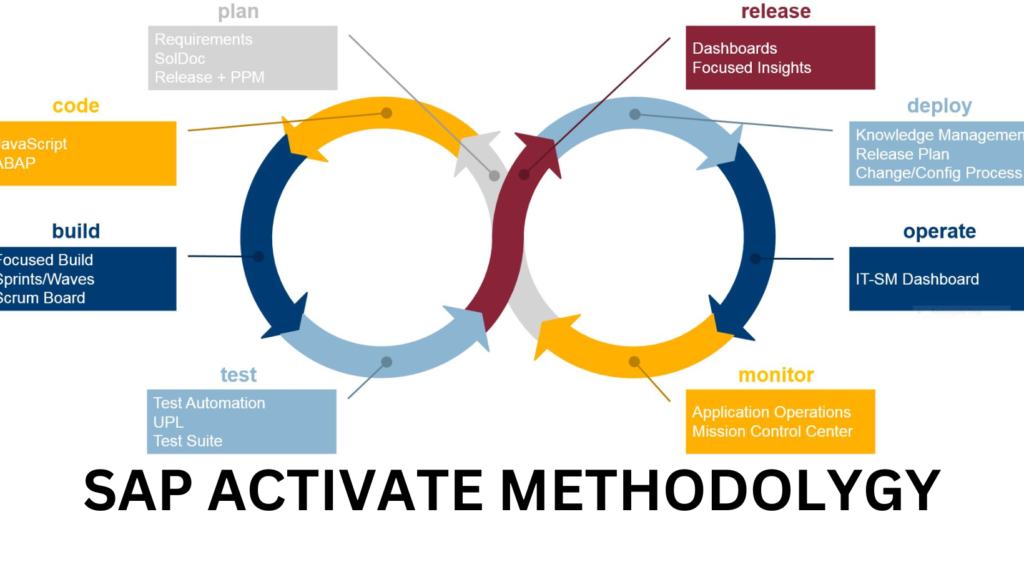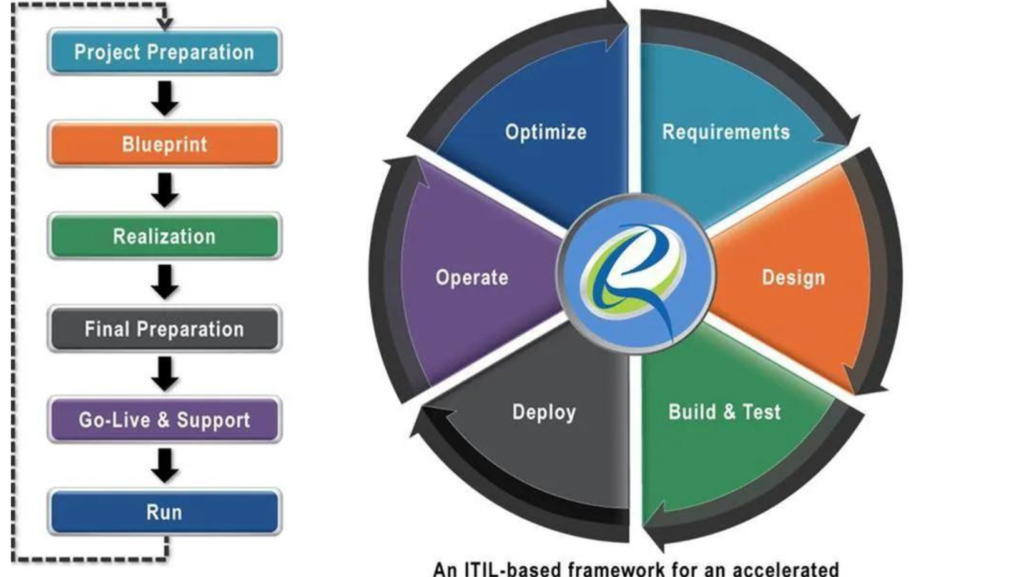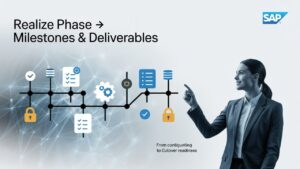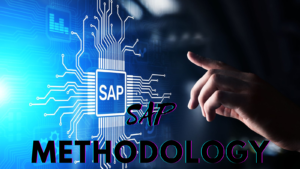Table of Contents
Introduction- SAP Activate Methodology
SAP Activate Methodology -The success of any business today heavily relies on efficient and streamlined processes that can adapt to the ever-changing landscape of the digital era. This is where SAP Activate Methodology shines as a revolutionary approach that simplifies success for businesses. In this article, we will explore the key principles, components, benefits, and best practices of SAP Activate Methodology, along with real-life case studies that showcase its effectiveness.

Understanding SAP Activate Methodology
Definition and key principles
SAP Activate Methodology is a comprehensive framework that guides businesses through the entire lifecycle of implementing SAP solutions. It is built upon three key principles: agility, innovation, and simplification. By emphasizing these principles, SAP Activate Methodology enables businesses to rapidly and successfully implement SAP solutions while minimizing complexities and risks.
Overview of the framework and its components
The SAP Activate Methodology framework consists of several distinct phases that ensure a seamless implementation process. These include the Project Preparation Phase, Discovery Phase, Design Phase, Build Phase, Deploy Phase, and Run Phase. Each phase has specific tasks and deliverables that contribute to the overall success of the implementation.
The Evolution of SAP Activate Methodology

Historical context and development milestones
SAP Activate Methodology has evolved over time to meet the changing needs of businesses. It builds upon the success of previous methodologies, such as ASAP (Accelerated SAP), SAP Launch, and SAP Solution Manager. These methodologies laid the foundation for SAP Activate, which incorporates the best practices and lessons learned from previous implementations.
Comparison with traditional project management methodologies
Unlike traditional project management methodologies, SAP Activate Methodology is highly adaptable and iterative in nature. It embraces agile principles and allows for continuous feedback and adjustments throughout the implementation process. This flexibility enables businesses to respond quickly to changing requirements and market dynamics, resulting in more successful outcomes.
Key Components of SAP Activate Methodology

A. Project Preparation Phase
Assessing project goals and objectives During this phase, the project team identifies the specific goals and objectives that the SAP implementation aims to achieve. This aligns the project with the overall business strategy and sets clear expectations for success.
Forming the project team and stakeholders The project team, consisting of key stakeholders, is formed during the Project Preparation Phase. This ensures that the right expertise and perspectives are represented, enabling effective decision-making throughout the implementation.
B. Discovery Phase
Conducting a preliminary scoping and feasibility study In the Discovery Phase, a preliminary scoping and feasibility study is conducted to identify the specific requirements and challenges that the SAP implementation should address. This step ensures that the solution is feasible and aligned with the business needs.
Identifying business processes and requirements During this phase, the project team thoroughly analyzes the existing business processes and requirements. This step helps identify areas for improvement and enables the design of an optimized solution that aligns with the organization’s goals.
C. Design Phase
Creating a high-level design and solution architecture In the Design Phase, a high-level design and solution architecture are created based on the identified requirements. This design serves as a blueprint for the configuration and development activities that follow.
Defining the scope and configuration requirements The project team works closely with stakeholders to define the scope of the SAP implementation and identify the specific configuration requirements. This ensures that the solution meets the organization’s unique needs and delivers the expected outcomes.
D. Build Phase
Developing and configuring the SAP system During the Build Phase, the SAP system is developed and configured based on the design and configuration requirements defined in the previous phases. This step involves coding, customization, and integration activities to ensure a seamless implementation.
Conducting unit testing and quality assurance To ensure the quality and reliability of the SAP system, thorough unit testing and quality assurance are conducted. This step identifies any errors or issues that need to be addressed before moving to the next phase.
E. Deploy Phase
Conducting user acceptance testing In the Deploy Phase, user acceptance testing is conducted to validate the functionality and usability of the SAP system. This involves involving end-users to ensure that the solution meets their needs and expectations.
Preparing for system go-live and post-production support The project team prepares for the system’s go-live by finalizing the necessary documentation, training materials, and support processes. This ensures a smooth transition to live operations and provides ongoing support for any post-production issues.
F. Run Phase
Transitioning to live operations During the Run Phase, the SAP system is transitioned to live operations. This includes data migration, system configuration, and end-user training to ensure a successful go-live and seamless adoption of the new system.
Ongoing system maintenance and optimization After the go-live, the organization enters the Run Phase, where ongoing system maintenance and optimization activities take place. This includes monitoring system performance, addressing user feedback, and implementing continuous improvement initiatives.
Benefits and Advantages of SAP Activate Methodology
Implementing SAP Activate Methodology offers numerous benefits and advantages for businesses, including:
Accelerated implementation timeline: SAP Activate Methodology enables businesses to achieve faster time-to-value by leveraging agile principles and iterative development cycles.
Enhanced project visibility and control: The framework provides clear milestones, deliverables, and governance structures, which enhance project visibility and enable effective control over the implementation process.
Improved adaptability to changing business needs: SAP Activate Methodology embraces agile principles, allowing businesses to respond quickly to changing requirements and market dynamics, ensuring a solution that remains relevant and aligned with evolving business needs.
Increased return on investment (ROI) and cost savings: By streamlining processes, optimizing workflows, and leveraging best practices, SAP Activate Methodology helps businesses achieve cost savings and maximize their ROI.
Case Studies: Real-Life Examples of Success

Let’s explore two real-life case studies that demonstrate the success of SAP Activate Methodology:
Company A: Streamlining operations and increasing efficiency
Company A, a global manufacturing company, implemented SAP Activate Methodology to streamline its operations and increase operational efficiency. By leveraging the framework’s agile and iterative approach, the company successfully integrated its various business processes and systems into a single SAP solution. As a result, they experienced significant improvements in production efficiency, reduced operational costs, and enhanced decision-making capabilities.
Company B: Enabling digital transformation and scalability
Company B, a fast-growing technology startup, sought to enable digital transformation and scalability by implementing SAP solutions. The company adopted SAP Activate Methodology, which allowed for rapid prototyping, quick feedback loops, and continuous improvements. This approach enabled them to seamlessly integrate new technologies, expand their customer base, and quickly adapt to changing market demands, resulting in accelerated growth and sustainable success.
Best Practices for Successful Implementation

To ensure a successful implementation of SAP Activate Methodology, businesses should follow these best practices:
A. Strong Project Management

Assigning a dedicated project manager Having a dedicated project manager ensures effective coordination, risk management, and timely decision-making throughout the implementation.
Establishing clear communication channels and workflows Clear communication channels and workflows facilitate effective collaboration among project team members and stakeholders, ensuring that everyone is aligned and engaged.
B. Stakeholder Engagement and Change Management
Involving key stakeholders from the beginning Engaging key stakeholders from the early stages of the implementation fosters a sense of ownership and accountability, increasing the likelihood of success.
Conducting user training and providing support Training end-users on the new SAP system and providing ongoing support ensures smooth user adoption and minimizes resistance to change.
C. Data Migration and Integration
Ensuring data accuracy and completeness Thoroughly validating and cleansing data before migration ensures the accuracy and completeness of information in the new SAP system.
Integrating SAP with existing systems/interfaces Integrating SAP with existing systems and interfaces enhances data exchange and ensures seamless interoperability across the organization.
Challenges and Risks of Implementing SAP Activate Methodology

While SAP Activate Methodology offers many advantages, businesses should also be aware of the following challenges and risks:
Change resistance within the organization: Implementing a new system and processes may experience resistance from employees. Effective change management strategies and open communication are crucial to address this challenge.
Technical complexities and integration issues: Integrating SAP solutions with existing systems and interfaces may pose technical complexities that require expertise and careful planning to overcome.
Potential budget and resource constraints: Implementing SAP Activate Methodology may require significant investment in terms of both financial resources and skilled personnel. It’s important to carefully plan and allocate resources to ensure a successful implementation.
Addressing Common FAQs about SAP Activate Methodology
Here are some frequently asked questions about SAP Activate Methodology:

Is SAP Activate Methodology suitable for all business sizes?
Yes, SAP Activate Methodology can be tailored to the unique needs of businesses of all sizes. It provides a scalable and flexible framework that accommodates the specific requirements and complexity levels of different organizations.
How long does a typical SAP implementation using Activate Methodology take?
The duration of a SAP implementation using Activate Methodology depends on various factors, such as the scope of the project, organizational readiness, and complexity of business processes. While each implementation is unique, SAP Activate Methodology’s agile approach accelerates the overall timeline compared to traditional methodologies.
What level of technical expertise is required for implementing SAP Activate Methodology?
Implementing SAP Activate Methodology requires a certain level of technical expertise, especially in SAP solutions and related technologies. It is recommended to involve experienced consultants or partners who possess the necessary skills and knowledge to ensure a successful implementation.
In a rapidly evolving digital landscape, businesses need a methodology that simplifies success and accelerates their transformation. SAP Activate Methodology provides the framework and tools needed to revolutionize businesses, enabling rapid implementation, enhanced adaptability, and increased returns on investment. Embracing this revolutionary approach will position businesses for sustainable success and thrive in an increasingly competitive marketplace. It’s time to take action and unlock the full potential of your business with SAP Activate Methodology!




Thank you for sharing the details
You explained very well